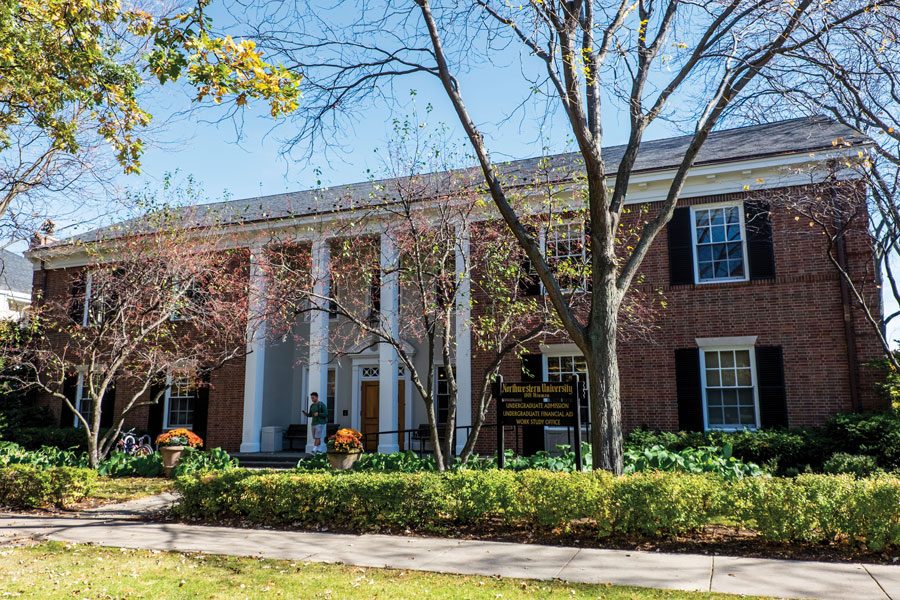Work-study doesn’t work for everyone: students share challenges, obstacles to robust employment on campus
Daily file photo by Jeffrey Wang
The Office of Financial Aid, where the Work Study Office is housed. Students have struggled with figuring out how work study fits into a financial aid package.
April 15, 2019
Miranda Chabot works two jobs. On Tuesdays and Thursdays, she gets techy — she’s a member of Northwestern News Network’s production crew. Her other job is a little more flexible hour-wise: as a research assistant, she makes her own schedule.
Chabot, a Medill first-year, is one of the hundreds of students at the University who qualify for Federal Work-Study – a program created by Congress in the 1960s to supply college students with part-time employment opportunities. The goal — to help students afford college while simultaneously affording them valuable work experience — seems straightforward. But today, decades after the program’s inception, some students feel shortchanged.
Part of the problem, students said, is that work-study money is far from a guarantee. Chabot said given NNN’s production schedule, it’s impossible for her to work — and, thus, earn — enough to fully cover her work-study allotment.
“Because of that, there’s a block on my financial aid statement that’s already in the red,” Chabot said. “Since there’s no guarantee you’ll be able to make what the University estimates you will in financial aid calculations, it’s fallen to me to figure out other options. I was lucky, but I’m sure not everyone else is.”
Chabot said it’s “insane” the University expects students to figure this out for themselves, adding that when she arrived, she didn’t understand that the number displayed on her financial award was a potentiality — not a surefire assurance. Chabot was able to find a backup plan, her research assistantship, but that’s also meant having to balance two jobs on top of school, social commitments and everything in between.
For some students, like Medill first-year Maggie Galloway, there are other problems with the work-study system: wages. Galloway said she loves her job at the Medill Office of External Programs and the flexibility she’s received as an employee but wishes there was more wage differentiation made between jobs of varying intensity.
“When I go into work, I have to actively be doing things. If there’s nothing to do, I have to go home,” Galloway said. “So it doesn’t make sense to me that I earn the same amount as students who are able to chill and do homework while also working.”
Because many lower-intensity positions are low in scope and high in demand it’s difficult for many students to access them, Chabot said, drawing from personal experience. By the time she set up an interview for a library position in the fall, the job was filled.
The problem is not that there aren’t enough opportunities, Galloway said; she didn’t find it “difficult” to find a job. Rather, structural problems — a “dated” job platform, University transparency issues and red tape — have been the largest source of complication.
And then there’s the issue of which students qualify for work-study at all.
Medill first-year Anna Margevich said while her financial aid package covers all her tuition, not being eligible for work-study disqualifies her from the majority of job opportunities on campus.
“It definitely makes it more difficult to find jobs,” Margevich said. “It makes sense on one level that (the University) is prioritizing job opportunities for students who don’t get full coverage. But, if you think about it, students with full financial aid — who come from less affluent backgrounds — may need those jobs more.”
Margevich said the main alternative has been searching for opportunities in Evanston, which comes with its “own set of challenges”: It can be hard to find work amenable to student life in the city.
For some students, work-study, in large part, has worked. Weinberg first-year Isabella Pizarro said she found it relatively easy to take advantage of job options offered by the University. Now, she works to connect with alumni at Phonathon.
But across the board, there’s something that students can agree on: there is no single work-study experience.
“There needs to be more information about how the system works,” Chabot said.
Email: pbaskar@u.northwestern.edu
Twitter: @pranav_baskar


